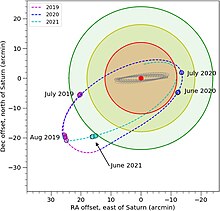 S/2019 S 1 on the day of its discovery, revealed by
stacking multiple images to its motion | |
| Discovery [1] | |
|---|---|
| Discovered by | E. Ashton et al. |
| Discovery date | 2019 (announced 2021) |
| Designations | |
| e26r58a12 [2] | |
| Orbital characteristics [1] | |
| 11221100 km | |
| Eccentricity | 0.623 |
| 443.78 days | |
| Inclination | 44.4° |
| Satellite of | Saturn |
| Group | Inuit group ( Kiviuq) [3] [2] |
| Physical characteristics [4] | |
Mean diameter | 5+30% −15% km |
| Albedo | 0.06 (assumed) |
| 25.3 | |
| 15.3 | |
S/2019 S 1 is a natural satellite of Saturn. Its discovery was announced by Edward Ashton, Brett J. Gladman, Jean-Marc Petit, and Mike Alexandersen on 16 November 2021 from Canada–France–Hawaii Telescope observations taken between 1 July 2019 and 14 June 2021. [1]

S/2019 S 1 is about 5 kilometres in diameter, and orbits Saturn at an average distance of 11.2 million km (7.0 million mi) in 443.78 days, at an inclination of 44° to the ecliptic, in a prograde direction and with an eccentricity of 0.623. [1] It belongs to the Inuit group of prograde irregular satellites, and is among the innermost irregular satellites of Saturn. [3] It might be a collisional fragment of Kiviuq and Ijiraq, which share very similar orbital elements. [4]
This moon's eccentric orbit takes it closer than 1.5 million km (0.93 million mi) to Iapetus several times per millennium. [4]
References
- ^ a b c d "MPEC 2021-W14 : S/2019 S 1". minorplanetcenter.net. Retrieved 16 November 2021.
- ^ a b Ashton, Edward; Gladman, Brett; Beaudoin, Matthew; Alexandersen, Mike; Petit, Jean-Marc (May 2022). "Discovery of the Closest Saturnian Irregular Moon, S/2019 S 1, and Implications for the Direct/Retrograde Satellite Ratio". The Astronomical Journal. 3 (5): 5. Bibcode: 2022PSJ.....3..107A. doi: 10.3847/PSJ/ac64a2. S2CID 248771843. 107.
- ^ a b Ashton, Edward; Gladman, Brett; Beaudoin, Matthew; Alexandersen, Mike; Petit, Jean-Marc (October 2021). Detection biases favour retrograde over direct irregular moons. 53rd Annual DPS Meeting. American Astronomical Society. 308.09. Retrieved 17 November 2021.
- ^ a b c "S/2019 S 1 – Tilmann Denk".